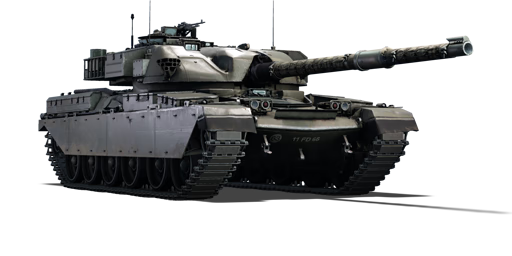

Ground Vehicles
Chieftain Mk 10
VI
Rank
AB
9.0
RB
9.0
SB
9.0
Battle rating
Great Britain
Research country
Medium tank
Main role
190,000

Research
520,000

Purchase
General information
Survivability and armour
Armour
front / side / back
Hull
86 / 38 / 25 mm
Turret
280 / 86 / 45 mm
Visibility
88 %
Crew
4 persons
Support systems
Mobility
Max speed
Forward
4853 km/h
Backward
1112 km/h
Power-to-weight ratio
13.311.725.320.6 hp/t
Engine power
7606721,4501,178 hp
Weight
57.2 t
Optics
Gunner
Commander
Driver
Optics zoom
7.0x–10.0x
1.0x–10.0x
—
Optical device
Armaments
120 mm Ordnance BL Tk. L11A5 cannon
Ammunition
53 rounds
First-order
19 rounds
Reload
basic crew → aces
9.7 → 7.5 s
Vertical guidance
-10 / 20°
Turret Rotation Speed
basic crew → aces
Horizontal
15.713.429.621.4 → 22.519.142.430.6 °/s
Vertical
15.712.655.135.3 → 22.51878.750.4 °/s
| Ammunition | Type | Armor penetration (mm) at a distance: | |||||
|---|---|---|---|---|---|---|---|
| 10 m | 100 m | 500 m | 1000 m | 1500 m | 2000 m | ||
| APDS | 298 | 296 | 288 | 277 | 268 | 258 | |
| HESH | 152 | 152 | 152 | 152 | 152 | 152 | |
| APFSDS | 410 | 408 | 405 | 400 | 390 | 380 | |
| Smoke | 5 | 5 | 5 | 5 | 5 | 5 | |
7.62 mm L8A1 machine gun (coaxial)
Ammunition
6,000 rounds
Belt capacity
200 rounds
Reload
basic crew → aces
10.4 → 8 s
Fire rate
1,000 shots/min
| Belt | Belt filling | Armor penetration (mm) at a distance: | |||||
|---|---|---|---|---|---|---|---|
| 10 m | 100 m | 500 m | 1000 m | 1500 m | 2000 m | ||
| AP/AP/T | 13 | 12 | 7 | 3 | 2 | 0 | |
7.62 mm L37A1 machine gun
Ammunition
2,000 rounds
Belt capacity
100 rounds
Reload
basic crew → aces
10.4 → 8 s
Fire rate
650 shots/min
Vertical guidance
-10 / 50°
Turret Rotation Speed
basic crew → aces
Horizontal
6353.6118.685.7 → 9076.5169.4122.4 °/s
Vertical
6350.4220.5141.1 → 9072315201.6 °/s
| Belt | Belt filling | Armor penetration (mm) at a distance: | |||||
|---|---|---|---|---|---|---|---|
| 10 m | 100 m | 500 m | 1000 m | 1500 m | 2000 m | ||
| AP/AP/T | 13 | 12 | 7 | 3 | 2 | 0 | |
Economy
Repair cost
Basic → Reference
AB
4,425 → 6,107 

RB
4,520 → 6,238 

SB
5,775 → 7,970 

Crew training
150,000 

Experts
520,000 

Aces
2,100 

Research Aces
950,000 

Reward multiplier
AB / RB / SB
150 / 200 / 230 % 

220 % 

Total cost of modifications
153,700 

261,000 

Talisman cost
2,600 

Research order:
Mobility | |
|---|---|
Protection |
|---|
Firepower | ||
|---|---|---|
Rating by players
You must play more than 3 battles for the last week and more than 10 battles in a vehicle to rate it.
Like:
106
Armor protection:
Not enough ratings
Survivability:
Not enough ratings
Mobility:
Not enough ratings
Armament:
Not enough ratings
Balance:
Not enough ratings
Tips & Tricks
This space is currently empty
Do you know any interesting vehicle features?
Loading...
No articles about this vehicle yet
Become the first author and get rewards!
Write a guide, tell about interesting historical facts, make a tutorial or simply an interesting post.
No more content